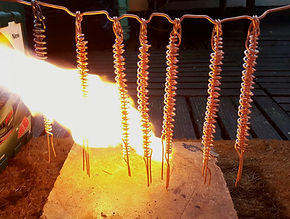PLASMA HEALTH
Improves your health and increases the quality of life
Nano Coating
Just mini or really Nano
'This is the first time we have been able to create a super conductor at room temperature since we are not dealing with electricity'. - M.T. Keshe

WHAT IS THE USE OF NANO COATING
In the study of plasma physics Nano particles and nano coated copper are used for two different purposes. The first use is to create GaNS, Gas at a Nano State, while the second is to act as a carrier or a conductor for the transmission of magnetic and gravitational fields.
WHAT IS NANO COATING
When treating a copper wire with an appropriate amount of cold caustic or hot caustic for a certain amount of time, the process elevates atoms from the material of the plate to a more structured distribution of the copper and its oxides on the surface of the metal.
The result is that the surface becomes super conducting to plasmatic fields, allowing the plasma from the universal field to flow through it. The surface will test as having infinite resistance and zero conductivity of matter state electric field flows.
FROM COPPER TO NANO
When we look at a piece of copper wire in its original state we will see that it has a positive charge. When we heat up the copper the outer layers will go from the solid state to a liquid, followed by a gas and then start to separate and release from itself. Once this happens, the polarity on the Nano particles flip from positive to negative.
What happens when we introduce positive and negative? They stick together correct? What we end up with is a copper wire that has a positive charge with negatively charged Nano particles stuck to it. We would see the first layer stick to the copper wire because we are dealing with a positive wire and a negative Nano particle, however the second layer and every layer after will not touch.
STEAM OR FIRE COATING
The base material for the coating is copper in any form. The coating is carried out either chemically by etching (steam coating with NaOH) or thermally by heating (fire coating by gas burner).
During the coating process "gaps between the (outer most layers of copper) atoms" are created. The coating is often referred to as nano-coating, the layers of which build up during the process of the creation of the coating.

A nano coated copper plate after the hot caustic method.

Triskelions on a mesh after hot caustic nano coating



A setup with nanocoated copper wire connected to iron nails in a container with 10% salty water to create Iron Gans, also called CH3 Gans.
Pouring boiling water on a thin layer of caustic (NaOH) on the bottom and copper plates laying on a mesh just above it for steam coating.
Copper Pens being coated with a gas burner. Of the three ways of coating being hot caustic, cold caustic and with fire, the latter is not the best way.


Far left: nano coated copper health pens, spirals and triskelions. Cold caustic method.
Left: the shiny surface of black nano coated copper spiral in resin in a health pen.
OVERVIEW
We now understand that nano particles are individual atoms of their original source that are no longer attached to one another. They are usually a mixture of oxides of the metal base, and occasionally some carbon/graphene layers. We use them for the fields that create them. Their fields are pulling in and pushing out other surrounding fields through their mag/grav field strength differences or gradients.

ATOM SPACING
The spacing of the atoms and layers produced by the nano coating method is a function of the process employed, and of the salts and other elements in the caustic mix that is used to create the nano layers. A good nano coating has between 30.000 and 40.000 layers.

LIKE A MAGNET
All of these Nano particles are negative polarity, and like a magnet they will push away from each other.
However, because the copper wire has a stronger gravitational field than the individual Nano particles, they will all be pulled towards the copper. What we end up with is layer upon layer of Nano particles that are attracted to the wire but repel from one another.
What we now see is a solid copper wire with layers on the outside made of Nano particles and in between these layers we have a flow of MAGRAV (magnetic and gravitational) plasmatic fields.
We now have a super conductor with no resistance. This is the first time we have been able to create a super conductor at room temperature since we are not dealing with electricity.
In this excellent video by the Keshe Foundation the information given here on this page about the nano layering process is explained again in an animation video.
